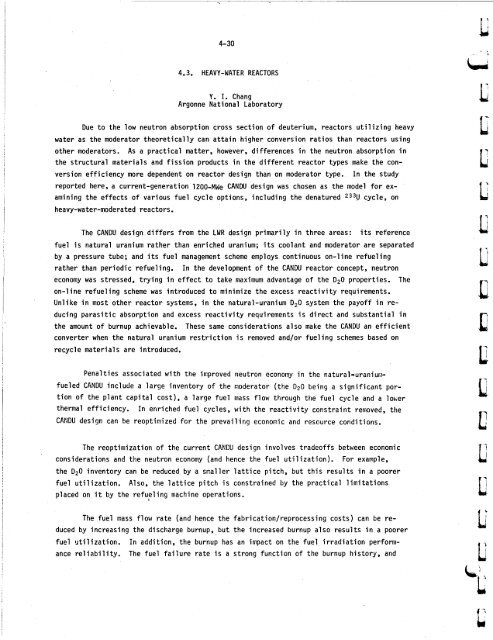ORNL-5388 - the Molten Salt Energy Technologies Web Site
ORNL-5388 - the Molten Salt Energy Technologies Web Site
ORNL-5388 - the Molten Salt Energy Technologies Web Site
You also want an ePaper? Increase the reach of your titles
YUMPU automatically turns print PDFs into web optimized ePapers that Google loves.
I<br />
4-30<br />
4.3. HEAVY-WATER REACTORS<br />
Y. I. Chang<br />
Argonne National Laboratory<br />
Due to <strong>the</strong> low neutron absorption cross section of deuterium, reactors utilizing heavy<br />
water as <strong>the</strong> moderator <strong>the</strong>oretically can attain higher conversion ratios than reactors using<br />
o<strong>the</strong>r moderators. As a practical matter, however, differences in <strong>the</strong> neutron absorption in<br />
<strong>the</strong> structural materials and fission products in <strong>the</strong> different reactor types make <strong>the</strong> con-<br />
version efficiency more dependent on reactor design than on moderator type. In <strong>the</strong> study<br />
reported here, a current-generation 1200-MWe CANDU design was chosen as <strong>the</strong> model for ex-<br />
amining <strong>the</strong> effects of various fuel cycle options, including <strong>the</strong> denatured 233U cycle, on<br />
heavy-water-moderated reactors.<br />
The CANDU design differs from <strong>the</strong> LWR design primarily in three areas: its reference<br />
fuel is natural uranium ra<strong>the</strong>r than enriched uranium; its coolant and moderator are separated<br />
by a pressure tube; and its fuel management scheme employs continuous on-line refueling<br />
ra<strong>the</strong>r than periodic refueling.<br />
economy was stressed, trying in effect to take maximum advantage of <strong>the</strong> D20 properties.<br />
on-line refueling scheme was introduced to minimize <strong>the</strong> excess reactivity requirements.<br />
Unlike in most o<strong>the</strong>r reactor systems, in <strong>the</strong> natural-uranium D,O system <strong>the</strong> payoff in re-<br />
ducing parasitic absorption and excess reactivity requirements is direct and substantial in<br />
<strong>the</strong> amount of burnup achievable. These same considerations also make <strong>the</strong> CANDU an efficient<br />
converter when <strong>the</strong> natural uranium restriction is removed and/or fueling schemes based on<br />
recycle materials are introduced.<br />
In <strong>the</strong> development of <strong>the</strong> CANDU reactor concept, neutron<br />
Penalties associated with <strong>the</strong> improved neutron economy in <strong>the</strong> natural-uranium-<br />
fueled CANDU include a large inventory of <strong>the</strong> moderator (<strong>the</strong> D20 being a significant por-<br />
tion of <strong>the</strong> plant capital cost), a large fuel mass flow through <strong>the</strong> fuel cycle and a loher<br />
<strong>the</strong>rmal efficiency. In enriched fuel cycles, with <strong>the</strong> reactivity constraint reliioved, <strong>the</strong><br />
CANDU design can be reoptimized for <strong>the</strong> prevailing econonic and resource conditions.<br />
The reoptimization of <strong>the</strong> current CANCU design involves tradeoffs between economic<br />
considerations and <strong>the</strong> neutron economy (and hence <strong>the</strong> fuel utilization). For example,<br />
<strong>the</strong> D20 inventory can be reduced by a snaller lattice pitch, but this results in a poorer<br />
fuel utilization. Also, <strong>the</strong> lattice pitch is constrained by <strong>the</strong> practical limitations<br />
placed on it by <strong>the</strong> refufling machine operations.<br />
The fuel mass flow rate (and hence <strong>the</strong> fabrication/reprocessing costs) can be re-<br />
duced by increasing <strong>the</strong> discharge burnup, but <strong>the</strong> increased burnup also results in a poorer<br />
fuel utilization. In addition, <strong>the</strong> burnup has an impact on <strong>the</strong> fuel irradiation perform-<br />
ance reliability. The fuel failure rate is a strong function of <strong>the</strong> burnup history, and<br />
The



![Review of Molten Salt Reactor Physics Calculations [Disc 2]](https://img.yumpu.com/21979492/1/190x247/review-of-molten-salt-reactor-physics-calculations-disc-2.jpg?quality=85)












